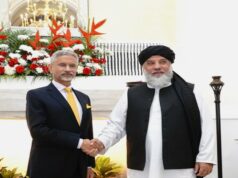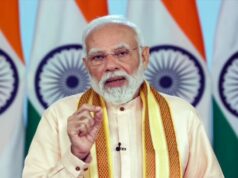“India will identify, track and punish every terrorist and their backers. We will pursue them to the ends of the Earth. India’s spirit will never be broken by terrorism. Terrorism will not go unpunished.” Two days after the terrorist attack in Pahalgam killed 26 people, Prime Minister Narendra Modi made those remarks at a public event in Bihar. The rest of his speech was in Hindi but those bits were in English, meant for the whole world. With Pahalgam, a red line has been breached. All those killed were civilian tourists. A nation in outrage is demanding revenge. Quite similar to what happened in September 2016 when terrorists killed 19 soldiers at a brigade headquarters in Uri. “I assure the nation that those behind this despicable attack will not go unpunished,” PM Modi had then said.
Given below are edited excerpts from my book ‘Securing India: The Modi Way’ which describe the testing times Post-Uri that ultimately led to the cross-border surgical strikes.
Uri Terror Attack, 2016
For Col H and Col K (names withheld), the moment of reckoning arrived on the afternoon of 18 September 2016.
Throughout that morning, the Commanding Officers (COs) of two separate Para (Special Forces) battalions were like most of their colleagues posted in Kashmir Valley, following the increasingly grim news coming out of Uri, the garrison town not very far from Srinagar.
Well-trained and well-informed terrorists of the Lashkar-e-Toiba (LeT) had infiltrated across the Line of Control (LoC) and attacked an administrative camp in the 12 Brigade HQ located in Uri with deadly effect.
At least 19 soldiers of 6 Bihar battalion, camping in tents—days before they were to take their assigned positions along the LoC—were killed in the early morning attack. Majority of the soldiers died in their sleep, resting as they were in highly inflammable tents.
Although all the four terrorists were neutralised eventually, they had set off a chain of events that would culminate on the morning of 29 September.
But I am getting ahead of the story.
As the death toll kept rising by the hour—three, four, 10, 17 and ending on 19—the two SF COs knew they were going to have a busy time ahead.
‘It Was Terrible’
In Udhampur, Northern Army Commander Lt Gen DS Hooda was distressed. He had been the GOC-in-C for over two years and witnessed his share of successes and setbacks as the head of India’s most active Army command. Nevertheless, this was possibly the worst moment of his long and distinguished career, spent fighting insurgencies and terrorism in the north-east as well as Jammu & Kashmir. ‘It was terrible. Very difficult to justify what happened. There were definitely lapses on our part,’ Hooda says in retrospect.
But an Army Commander doesn’t have the luxury of wallowing in his own state of mind. He has to set an example by leading from the front.
As he accompanied Army Chief Gen Dalbir Singh to Uri, Hooda knew the time had come to implement a plan, the seeds of which had vaguely taken shape in his mind some fifteen months ago. Even Gen Dalbir, aware of how the Prime Minister’s mind worked, was thinking of something different.
The General’s Hunch
Gen Dalbir, who had served all his life in combat zones—from North-east to Kashmir and in Sri Lanka—was a pragmatic leader. He planned well, refused to rush into a decision even when pressure was put on him to take immediate retaliatory action, and had interacted with Prime Minister Modi long enough since May 2014 to realise that Modi would not let the Uri attack go unpunished. So, the moment he returned to Delhi, Gen Dalbir told his DGMO to draw up plans to launch cross-border strikes since he had sensed that the current government will seek punitive action against Pakistan for the recent attacks.
Gen Dalbir was drawing on his experience during the cross- border raid in Myanmar more than a year previously when the PM had quietly authorised the strike against north-east militants holed up in the jungles of Manipur-Myanmar border after killing 18 Indian soldiers. The General had a hunch then that the Prime Minister may demand a Myanmar-like action if push came to shove in J&K.
‘I recall telling my Northern Army Commander to start thinking on the lines of the Myanmar strike,’ Gen Dalbir said.
Preparing For A Strike
The success of Myanmar operations had planted the seed of thought about a surgical strike in Pakistan in everyone’s mind. Once during his visit to the Northern Command, then Defence Minister Manohar Parrikar too had exhorted top commanders to be prepared for every eventuality. ‘Although I didn’t spell it out explicitly, I knew some day a grave provocation by Pakistan may require a Myanmar-like operation. So I told the Army Chief and his senior commanders to look at every possible response,’ Parrikar recalls.
On his part, Lt Gen Hooda called the two COs (Col H and Col K) and told them that they needed to start looking at targets across the LoC, although frankly at that point in time (June 2015) neither Gen Dalbir, nor Lt Gen Hooda or the political leadership would have thought of such an eventuality arising. Till then, the thinking at the highest levels of India’s political and military leadership was any major trans-LoC strike would be deemed escalatory.
Remember, in Kargil, the Vajpayee government had imposed the strict restriction of NOT crossing the LoC in spite of a grave provocation.
‘I thought to myself, if tomorrow someone asks us to go, how can I, as Northern Army Commander say we are not prepared?’ Hooda remembers thinking.
Gen Dalbir says: ‘From my experience in planning and executing the Myanmar raids, I wanted my commanders to make sure that any cross-border raid should be carried out with minimum casualties. My instructions were, not one single soldier should be left behind in enemy territory even if we suffered any setback.’
Hence, in the immediate aftermath of the Myanmar operation, the two COs were told to seriously plan to hit targets inside PoK. Other senior officers in Northern Command’s planning staff also held discussions a couple of times with the MO (Military Operations Directorate at the Army HQ). They identified targets, looking for more intelligence inputs on them, and consolidating a thought process in the presence of the Army Chief and the Northern Army Commander.
‘Basically, we had started planning for a cross-border operation, something that had not been contemplated earlier…without this planning, both at Army HQ level and in Northern Command and a change in thought process, it would have been impossible to do what our boys eventually did. It is not something you do based on overnight planning,’ Gen Dalbir said.
But were not cross-border raids carried out earlier too, I asked Gen Dalbir. ‘Yes, they were,’ he agreed ‘but most actions taken in our younger days were, what we call, BAT (Border Action Team) raids on specific post(s) as retribution for something that the Pakistan Army troops would have carried out on our position(s),’ he said. ‘What we were now planning for was much larger with greater ramifications,’ he explained.
Drawing From Myanmar Ops
After the Myanmar Operation, Gen Dalbir had already passed orders to get better equipment for the Special Forces… ‘Immediately after Manipur, I had initiated a case for procurement of special equipment and weapons. Then we decided to equip at least two battalions of SF in the East and the North (Eastern and Northern Command) on a fast-track basis.’
This preparation and priming up of the Special Forces was necessary, since the two battalions, involved in a day-to-day engagement in Jammu and Kashmir for years, had somehow taken the focus away from their primary task of operating behind enemy lines and undertaking special operations in enemy territory.
So in the winter of 2015, the two SF battalions were told to concentrate fully on training for their conventional role (of infiltrating behind enemy lines and carrying out strategic strikes).
Although the COs were initially inclined to do both—carry out Counter-insurgency, Counter-terrorists (CI-CT) operations even while stepping up the battalions’ training for conventional operations— Hooda ordered them to just do the latter in peak winter. Both Gen Dalbir and the then Northern Army Commander remember receiving flak from some Special Forces veterans for their move. But neither of them were budging.
For two months in the winter of 2015, the two battalions trained as whole units after years of operating in small, agile teams against terrorists in J&K. This training was to prove crucial in sharpening the set of skills needed for raids across the LoC.
In a way, it was like revisiting their basic tenets for the Special Forces men. And they loved it. Although no one could have anticipated that they would be called in to strike across the LoC, the very thought of crossing a line that was seen as taboo motivated the troops further. Indeed for over two decades no one at the highest political level had ever expressed willingness to sanction, or had demanded such an action inside PoK for the fear of escalation.
‘The two to two-and-a-half months that these boys spent together helped them hone their skills in surveying targets, mount surveillance, practising infiltration and exfiltration, which in the final analysis helped them achieve what was asked of them,’ a senior officer in MO Directorate, privy to the development now agrees, looking back at that decision. As a result of the reorientation, by the time the summer of 2016 arrived, the two battalions had added an extra edge to their repertory of formidable skills.
However, no one—not even the most imaginative scriptwriter in Bollywood—could have anticipated the events as they unfolded in September 2016.
Uri Brought Rage, Frustration
Sunday, 18 September 2016 dawned with the worst news possible for the Indian Army and the nation.
A group of four heavily armed suicide attackers had trekked across the Haji Pir pass, infiltrated into the Uri sector and launched an assault on the administrative base of the 12 Brigade HQ located on the edge of the Uri Garrison. It was 0530 hours.
By 0900 hours, the terrorists were eliminated by the Army’s quick reaction team.
But not before they had killed 19 Indian soldiers. It was the biggest hit that the Army had taken in any terror attack in 15 years. The last such big loss, old timers remember, was during an attack on the Kaluchak Army camp in 2002 when 22 soldiers were killed in a similar suicide attack.
The Army was shaken. And angry. For too long, the Army had been taking casualties in its own camps without hitting back in the same fashion.
Across the board, the langar gup (mess gossip) was full of frustration and rage. I remember speaking to some middle level officers posted in J&K in the immediate aftermath of the Uri incident. The anger was palpable. ‘If this is not the last straw, what is,’ many of them wondered aloud when the possibility of the Indian army’s retaliation was discussed. NSA Doval too remembers Prime Minister Modi telling him: ‘This attack should not go without a response.’ Gen Dalbir adds: ‘During one of the meetings in the immediate aftermath of Uri, the Prime Minister said the retaliation should be immediate to send an unambiguous message.’
Parrikar, Doval and Gen Dalbir however knew they had to plan for several contingencies before attempting a Myanmar-style cross- border raid. For one, unlike on the Myanmar border, the Pakistani forces strung all along the LoC were on highest alert in the wake of the Uri attack. The terrorists would have also been told to lie low and shifted to camps located farther away from the LoC so that hitting those targets would have become harder.
Moreover, no matter how remote the possibility, India had to war game the likely escalation by Pakistan if retribution was ordered.
String Of Meetings After Uri Attack
Defence Minister Parrikar, reviewing the preparedness of the forces, recalls how he had held a number of meetings within a week of the Uri attack and ordered fast track purchases of critical ammunition, spare parts and crucial equipment. ‘It became apparent from the briefings I received from the Army Chief that we had to be prepared for a possibility of a short, swift skirmish, if not a conflict, once it had been decided to order a retaliatory strike,’ Parrikar says.
Many deficiencies—which were in the process of being overcome in the normal course but would have taken at least another year—had to be made up in double quick time.
‘In the week after the Uri attack, I remember chairing some 18- 20 meetings taking stock of the urgent needs,’ Parrikar said.
Multiple conversations with those involved in the process reveals that India procured equipment, platforms, spares and ammunition worth anything between Rs 20,000 to 25,000 crores in the immediate aftermath of the Uri attack. Parrikar recalls he had to cut through red tape ruthlessly in order to get the deliveries on time.
On ground however, neither Col H nor Col K were aware of or concerned about the high level confabulations. They were focused on the task they knew they had to do. This was a chance they knew they would never get again. This was the once-in-a-lifetime opportunity Special Forces wait for. ‘The day Uri happened, we had, in our mind, decided where to hit, how to hit the other side since we had already planned for this eventuality in the previous six-eight months,’ Col H said. ‘We knew this incident called for a punitive response. There was no way this government would allow the Uri incident to go unpunished,’ Col K added. ‘Our boys were angry, not sad. They kept saying ‘ek bada sabak sikhana padega Pakistan ko’ (we have to teach Pakistan a big lesson). We knew, the strike will have to be big enough to inflict major damage. A token raid would not have been sufficient,’ both the COs recalled during our conversation. And sure enough, the call came from Udhampur by the evening of 19 September. The Army Commander wanted them at the Northern Command HQ forthwith.
The countdown to the surgical strikes had begun!
On 20 and 21 September, several briefings and discussions took place in the Command HQ’s operations room. The focus was on specifics: targets, timing, methods. Only Lt Gen Hooda, the MGGS, the BGS and the two Commanding Officers were privy to the discussions.
As the two COs and the Northern Command MGGS and BGS got down to finalising the minutest of details, Lt Gen Hooda flew to Delhi at least thrice in that week between the Uri attack and the surgical strikes, to sit down with the DGMO and select officers of the Military Operations (MO) Directorate to fine-tune the plans.
Testing Time For Modi
The week of the Uri attack was also a testing time for the Prime Minister’s leadership. Modi, adept at judging the public mood, was aware that people expected him to ‘walk the talk’ in acting tough against India’s implacable enemy.
Public opinion in the country was inflamed. People were calling for an all-out war against Pakistan. Even saner voices were advocating at least some demonstrable retribution. Modi was aware of the public sentiment and the anger that was building up in popular perception. He vowed immediate retribution. ‘I assure the nation that those behind this despicable attack will not go unpunished,’ he tweeted on the day of the Uri attack. Not many people took the statement at face value. After all, politicians and prime ministers in the past had pledged stern action against terrorists and their handlers many times, but had ultimately refrained from giving that final go ahead required to retaliate, urging restraint instead.
Almost everyone thought it to be the standard condemnation— kadi ninda (severe condemnation)—as some commentators have often categorised politicians’ routine statements after each terrorist attack. However, the PM was clear in his mind that he cannot afford to be taken for granted like his predecessor, Dr Manmohan Singh, who often dithered and failed to launch any punitive action against Pakistan even after the outrageous attack on Mumbai in November 2008 that killed more than 170 people and made a mockery of India’s security apparatus.
Modi had himself strongly criticised Dr Singh’s inaction then.
Now, the ball was in Prime Minister Modi’s court.
The Opposition was up in arms. After a day or two of showing solidarity with the government and sympathy for those martyred, it was now mocking the government’s inability to punish Pakistan.
Newspapers were critical too. Strategic affairs analysts were also unsparing. Amidst all the criticism, the Prime Minister continued to be unruffled.
Uri Response Carefully Thought Through
Recall his aides: ‘The PM went through with his daily routine and pre-scheduled appointments and programmes without any change, but made sure he had all possible options presented to him before giving the final go ahead (for a punitive strike against Pakistan).’ But he was not about to be rushed into any hasty decision.
The Prime Minister however made up his mind by 23 September, five days after the Uri attack. Later that evening, he and Doval, escorted by a Major General from the MO Directorate, walked the length of the South Block Corridor from the PMO to the Army HQ Ops room around 2100 hours, much long after the corridors had been emptied and offices had closed. Already present in the room were Defence Minister Parrikar, Army Chief Gen Dalbir Singh, DGMO, Lt Gen Ranbir Singh, and a couple of MO Directorate senior functionaries.
The PM sat through the briefing silently, listening with rapt attention. He was presented various options, shown targets that were planned to be hit inside PoK, and briefed on the possible retaliation/ reaction by Pakistan.
Once the initial briefing was over, Modi had a couple of questions on other possible options like a precise air strike on terrorist camps, remembers a participant. Eventually, the Prime Minister agreed that a Special Forces raid across the frontier was the best possible course of action at that point, the participant added.
The PM’s situational awareness and sharp memory was also in evidence that night. When the subject of international reaction came up, he reminded everyone that External Affairs Minister Sushma Swaraj was to deliver her speech at the UN General Assembly in the next one week or so. The PM therefore ordered that the operation be timed after her speech. However, beyond giving general directions about the need to be careful, Modi did not get into specifics.
‘He left the planning and execution to us professionals,’ Doval told me.
So the professionals got down to business. Parrikar, Gen Dalbir and Doval analysed the situation and sent out instructions to the Northern Command for an ‘in-principle’ go ahead for a trans-LoC strike. ‘We told Udhampur (Northern Command HQ) to look for major terrorist camps. The idea was to destroy some of that infrastructure across the LoC in PoK,’ Gen Dalbir remembers.
All decisions were however taken after long deliberations and thorough discussions. ‘All of us knew that the Pakistani forces would be at their highest alert after the Uri attack, so we did not want to do anything rash,’ the then Army Chief said.
India’s external intelligence agency, the R&AW, and the Intelligence Bureau asked its operatives to assess the possible impact of a retaliatory strike inside PoK. ‘We needed to be ready for any possible backlash,’ a top intelligence operative recalls.
Gen Dalbir, cautious but pragmatic, also sought permission from Parrikar to redeploy some key formations just in case Pakistan decided to up the ante after the retaliation. ‘As Army Chief, the onus was on me to make sure we did not fall short of firepower,’ Gen Dalbir recalls thinking throughout the week following the Uri attack, planning far beyond the retaliatory strikes. ‘I had already moved some additional forces to the Kashmir Valley to reinforce the existing security grid following large scale unrest, after we had eliminated Burhan Wani (the Kashmiri local commander),’ Gen Dalbir revealed. ‘Now I had to make sure that other areas too were ready for any possible backlash,’ he told me.
So formations responsible for borders in Punjab and Rajasthan were put on alert. A review of shortages at the local level was carried out and orders passed to replenish inventory.
Meanwhile as debates—mostly acrimonious and bitter— continued to rage on television channels and in public discourse, the Indian security establishment was quietly preparing for a counter- strike on a scale that was always possible in theory, but had never been implemented in practice for fear of escalation.
As one week passed after the Uri attack, the debates tapered off; people seemed resigned to live with the bitter fact that the situation in J&K and on the LoC would continue to be volatile with the Indian army unable to take any deterrent steps.
Little did anyone know that India was about to unleash unprecedented and audacious cross-border strikes.
Nitin A. Gokhale is a media entrepreneur, one of South Asia's leading strategic affairs analyst and author of over a dozen books so far on military history, insurgencies and wars.
Starting his career in journalism in 1983, he has since led teams of journalists across media platforms.
A specialist in conflict coverage, Gokhale has covered the insurgencies in India’s North-East, the 1999 Kargil conflict and Sri Lanka’s Eelam War IV between 2006-2009.
Gokhale now travels across the globe to speak at seminars and conferences, and lecture at India’s premier defence colleges. He has founded three niche portals, Bharatshakti.in, stratnewsglobal.com and Interstellar.news.





